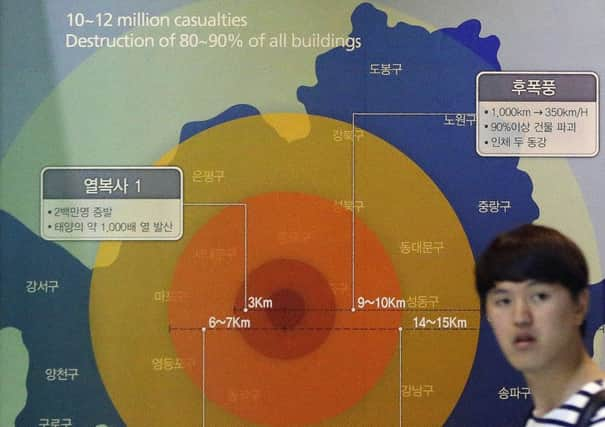World awaits new North Korea nuclear weapons


Neither announcement was entirely unexpected, and outside analysts see the back-to-back warnings as part of a general North Korean strategy of using claimed improvements in its nuclear and missile programmes to push for talks with the US that could eventually provide the impoverished country with concessions and eased sanctions.
But the threats could deepen a standoff between North Korea and the US and its allies because they strike at Washington’s fear that each North Korean rocket and nuclear test puts it another major step closer to its stated goal of an arsenal of nuclear-tipped long-range missiles that can hit the US mainland.
Advertisement
Hide AdAdvertisement
Hide AdNorth Korea has spent decades trying to develop just such a weapon, and while it is thought to have a small arsenal of atomic bombs and an impressive array of short- and medium-range missiles, it has yet to demonstrate that it can produce nuclear bombs small enough to place on a missile or can make reliable long-range missiles.
However, it has conducted three nuclear tests and a series of steadily improving long-range rocket launches, and some analysts see yesterday’s announcement as foreshadowing an upcoming fourth nuclear test, which would push North Korea further along in its nuclear aims.
North Korea said yesterday in its state media that, as it pledged to do in 2013, the plutonium and highly enriched uranium facilities at its main Nyongbyon nuclear complex have finally been “rearranged, changed or readjusted and they started normal operation.”
It said its scientists had improved “the levels of nuclear weapons with various missions in quality and quantity.”
North Korea, an autocracy run by the same family since 1948, closely controls information about its nuclear programme, which it describes as a sovereign right meant to combat US military hostility.
As a result, just what is happening at Nyongbyon is unclear. North Korea kicked out international inspectors in 2009, and independent assessments by outside experts since then have been in short supply.
At various points in the decades-long standoff over its nuclear ambitions, North Korea has said it has shut down or restarted its atomic fuel production.
In 2013, it said it would restart a plutonium reactor that had been shut down under a 2007 disarmament agreement.
Advertisement
Hide AdAdvertisement
Hide AdSatellite imagery earlier this year showed signs it still wasn’t operating fully. A uranium enrichment facility unveiled to a visiting American scientist in 2010 presumably gives North Korea a second way to make fissile material for bombs.
On Monday, the North’s aerospace agency said it is ready to launch new satellites aboard long-range rockets as part of celebrations of next month’s ruling communist party anniversary.
The world will “clearly see a series of satellites soaring into the sky at times and locations determined” by the Workers’ Party, an unidentified director at the North’s National Aerospace Development Administration was quoted as saying by state media.
North Korea has said its satellite launches are peaceful and meant for weather observation, but the West considers them covers for banned tests of long-range missiles. Analysts in Seoul said North Korea’s announcements suggest an imminent nuclear test.